Charging At Home & On The Road: How To Get Electrons Into Your EV
Once you’re ready to drive electric (we hope we helped convince you in our last post), you’ll have to determine how and where to charge your new electric ride. 80% of charging happens at home and 20% at destination and fast chargers, which are essential for road trips. Today we’ll address both types of charging and how to seamlessly get electrons into your car based on our seven years of driving electric and many, many long distance road trips.
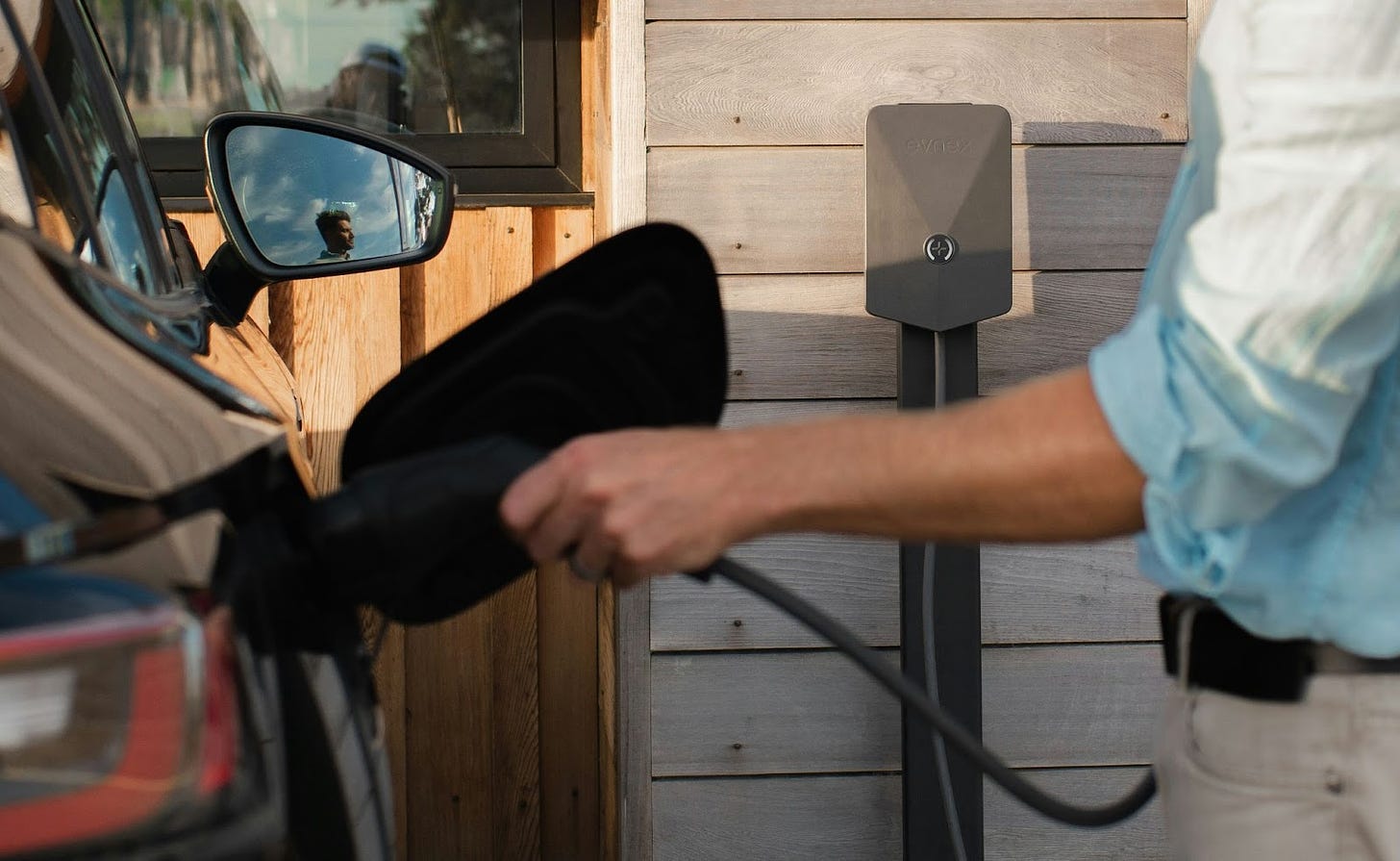
Charging at Home: Level 1 vs. Level 2
When we bought our first EV in 2017, we were surprised to learn we could plug it into a standard 120 volt outlet for Level 1 charging. This charging speed is sometimes referred to as “trickle charging” because it provides 3-5 miles of range per hour. It’s a totally reasonable option and worth a try if you’re a new EV owner debating about investing in a home charging station. Yes, it’s slow, but if you plug in every evening, you’ll get 40-60 miles overnight, which is generally enough for daily driving needs. (The average person drives 37 miles per day, which would take 7-12 hours of Level 1 charging depending on your vehicle.)
For our first four years of EV ownership, we relied on a standard outlet on the side of our house and it wasn’t that bad. It was a little clunky since we don’t have a garage or driveway (more on that below) but it worked. The big downside is that it sometimes required us to plan days ahead of time when fueling for a road trip, and without stopping at a fast charger, we couldn’t spontaneously go for a long drive. But we’re planners so this wasn’t too much of an issue for us.
If you want more flexibility and faster speeds, consider Level 2 charging. It provides 15-35 miles of range per hour flowing from a 240 volt outlet, which is the same type of outlet your dryer and electric stove use. This is also the same charging speed you’ll find at destination chargers like hotels or grocery stores. We upgraded to Level 2 in 2021 and now fully charge our 300-mile range vehicle overnight, which is hands down much more convenient.
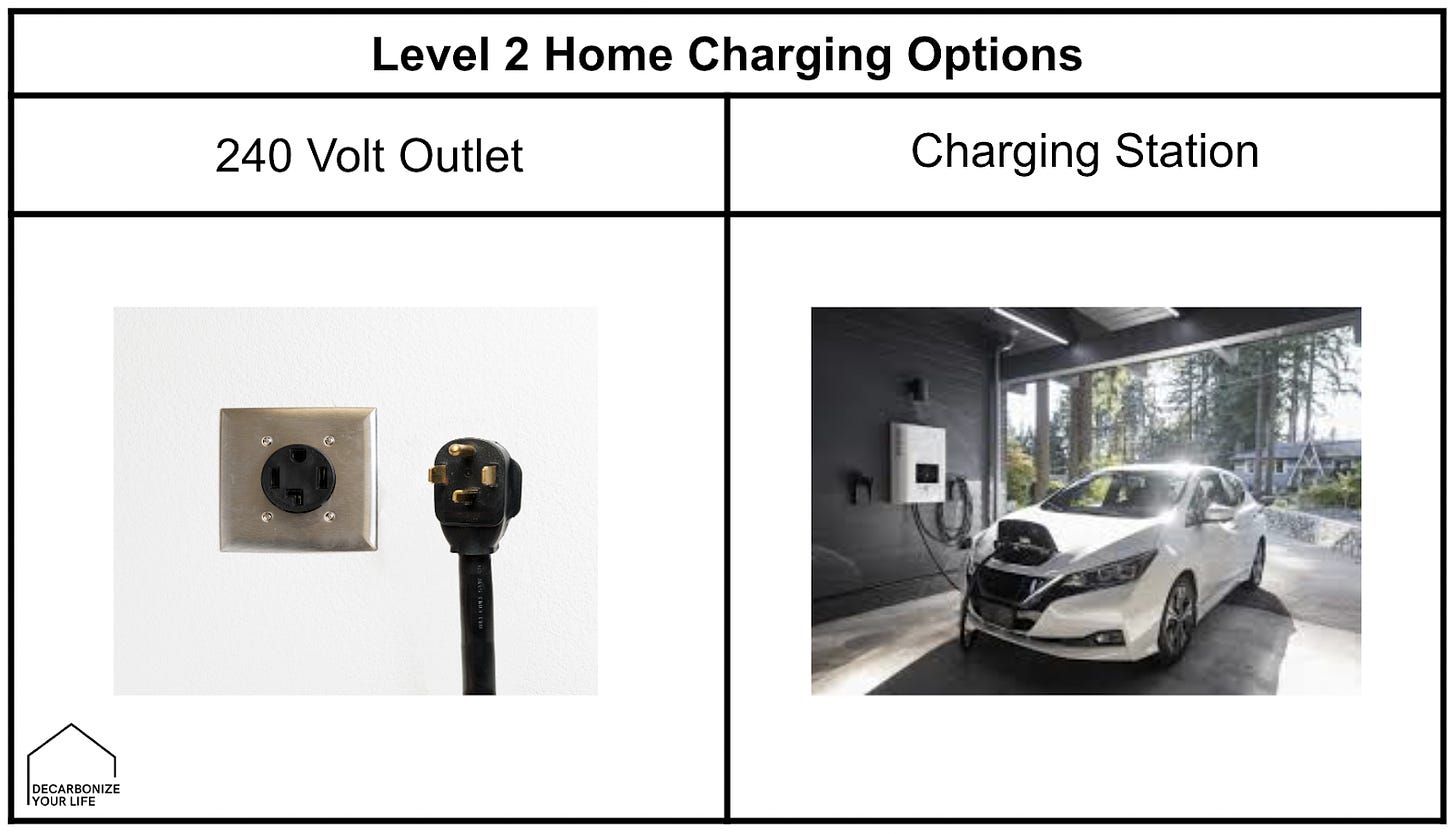
Likely the cheapest Level 2 charging solution is a simple 240 volt outlet because it doesn’t require a home charging station. However not all EVs come with a 240 volt charging cable (Tesla stopped including any charging cable with vehicles in 2022) so you may have to buy one to go this route.
The other option is a home charger, which offers the convenience of a built-in cord that plugs into your car, much like at a gas station. We went this route for a family house in Cleveland that’s often rented on Airbnb, and we wanted to encourage road-tripping guests to drive electric with the convenience and speed of Level 2. Home chargers come in many designs and charging speeds and currently range from $300-$700 plus the cost of install. Check if your utility offers a rebate for home chargers.
On a related note, some of the newest (and priciest) EVs and chargers enable drivers to power their homes during an outage by drawing on the electricity in an EV battery. Ford’s Lightning pickup truck was the first to do this, and Tesla, Chevy, and VW plan to follow suit.
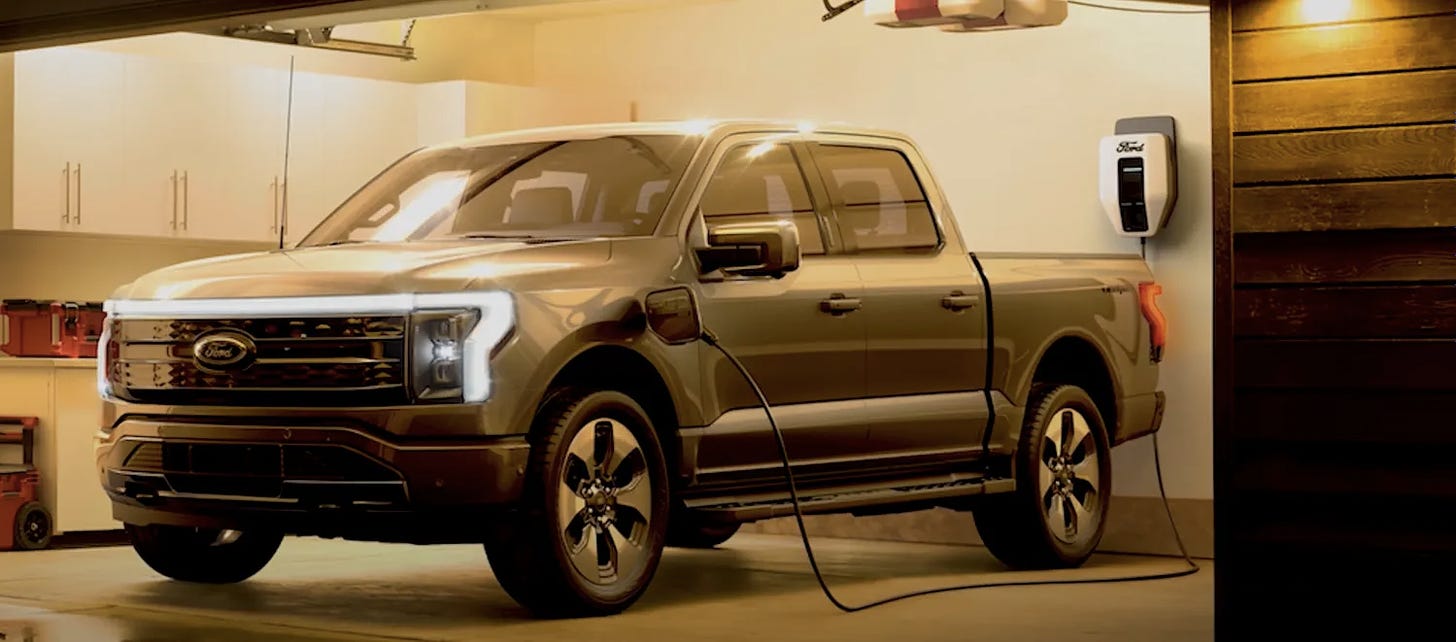
In addition to the higher cost of install, there are a couple other downsides of Level 2 charging. First, higher voltages may strain the local utility’s grid and require more carbon intensive fuel sources, which is what we all aim to avoid by driving electric. For this reason, it’s important to charge during off-peak hours, meaning the times of day where there’s not as much electricity demand. We enrolled in a local utility program that incentivizes us to charge at night. Second, older homes with smaller electrical panels might not have panel capacity for an EV charger. A potential workaround may be to share an existing 240 volt outlet between your EV and an appliance like your dryer using something called a “circuit splitter.” This device pauses your EV charging while you use the other appliance plugged into it.
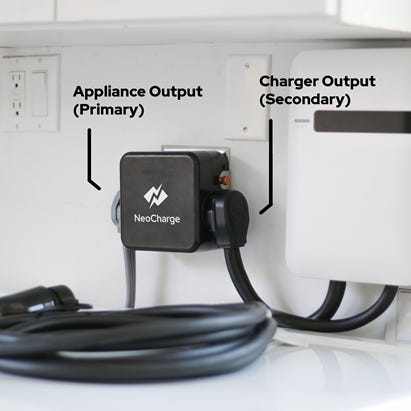
Charging as a Garage Orphan
These charging options are quite convenient if you live in one of the 63% of US homes with a garage or driveway. But if you live in one of the 37% of homes or apartments without dedicated parking, charging your EV can require a little creativity. But these “garage orphans,” as the industry calls them, can still go electric, albeit with a bit more planning. There is always the option of public charging stations, you can’t beat the convenience of charging at home so we offer a few charging hacks based on our personal experience.
While we are lucky enough to own our home, we’re technically garage orphans because we turned our garage into an Accessory Dwelling Unit and depaved our driveway to plant a garden. Since becoming car owners in 2017 (our first car was electric), we’ve parked on the street in front of our house. For four years, we charged our 85-mile range Nissan Leaf, and then 320-mile range Tesla, using a 50-foot extension cord that plugged into a 120 volt outlet on the side of our house and ran over our retaining wall and across the sidewalk.
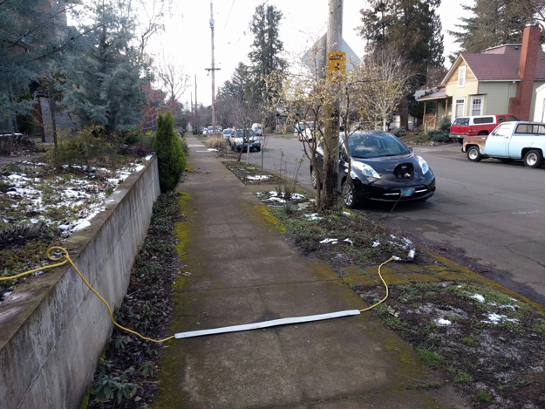
We wrote in depth about this a couple years ago, describing this clunky approach that required a cord protector strip to prevent neighbors from tripping, and a plastic box to cover the connection between the extension cord and car charger to keep it dry during Portland Oregon’s many rainy months. Was this setup ideal, attractive, or recommended by professionals? No. Did it work without issue for us? Yes. Do we recommend it to others based on our research? No.
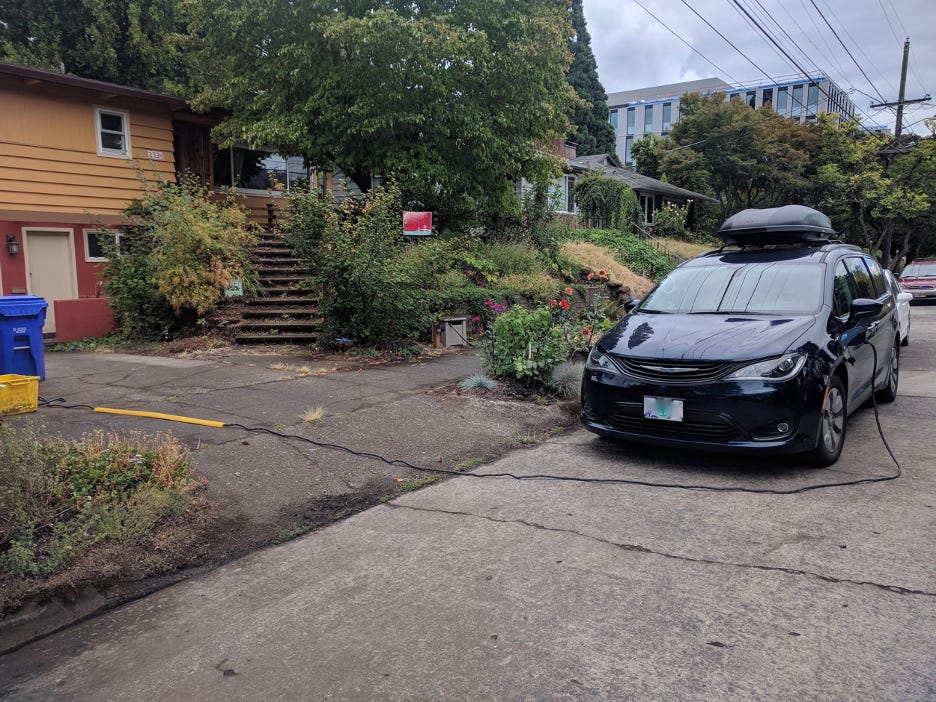
The more scalable, long term solution for garage orphans might come from cities and utilities partnering to provide on-street charging infrastructure that’s accessible for every apartment and home. While there are some early leaders, this reality is still a ways out.
Our Solution
Three years ago, we opted for a more sustainable charging hack: a Level 2 outlet closer to our car that does not require an extension cord. We opted for an affordable outdoor-rated outlet rather than an official Level 2 charging station. Joe dug the trench. An electrician made room in our circuit breaker and ran the outdoor-rated conduit to a new box attached to our retaining wall. Labor and parts came in around $500.
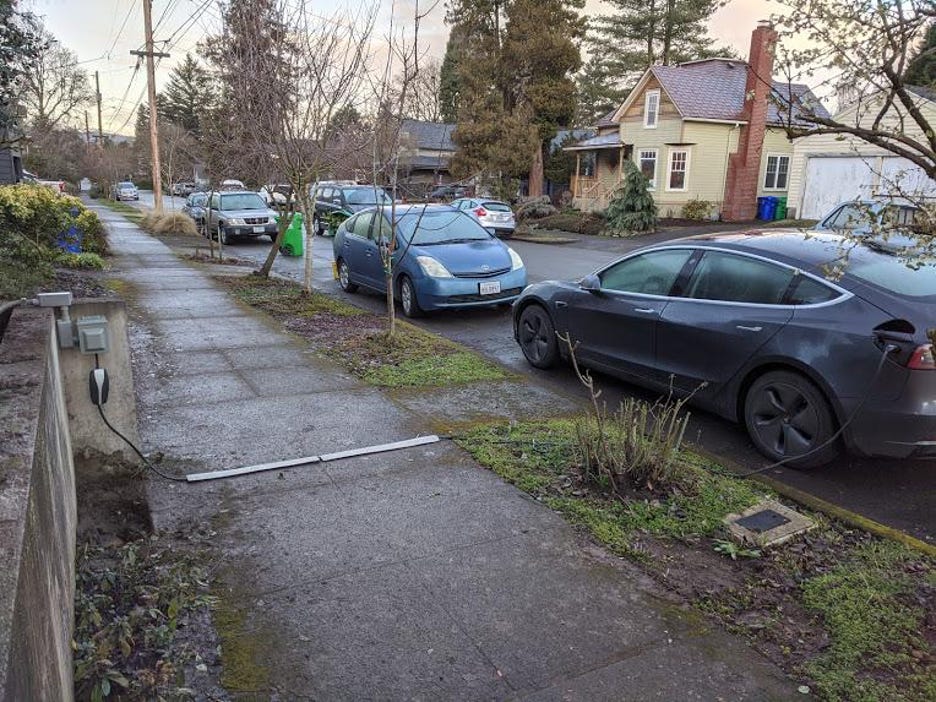
Since we park on the street, we still run the car’s charging cable across the sidewalk (and cover it with a new and improved cord cover) but there’s no longer a risk of the extension cord overheating. The charging time went from 50 hours to 5, so the cord crosses the sidewalk for much less time.
Charging on the Road: Level 3
Beyond the typical commute and around town outings, you’ll likely need to take advantage of fast charging stations on the road. The number of US Level 3 fast chargers has doubled in the last three years, but they aren’t as ubiquitous as gas stations (currently the ratio is one fast charging station for every 15 gas stations) so long distance driving still takes some planning.
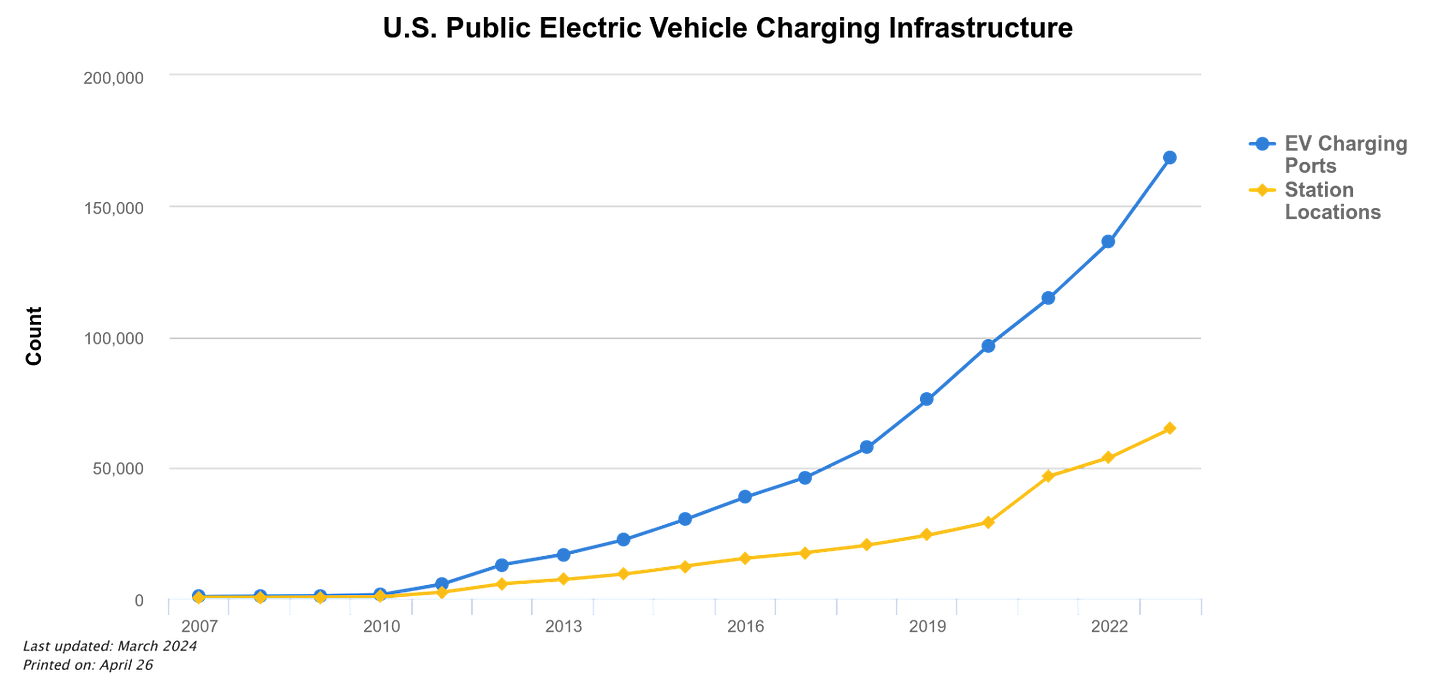
Most long distance charging occurs at Level 3 Fast chargers that are part of national networks, like Electrify America or Tesla Superchargers. Many cars and apps have the ability to plan a route for you, including where to stop and how long to charge, making EV road trips convenient and possible.
There’s no question Tesla has the best charging network. The number of chargers at each Supercharger station means you rarely have to wait your turn to charge. The charging process is seamless as the system stores credit card info, so all you have to do is plug in. No need to swipe, download an app, or call service, which we did more times than we like to admit with our Leaf. Teslas also know exactly how much charge will get you to your destination, so you won’t charge longer than necessary, and the car even prepares the battery in anticipation of charging to maximize charging speeds. Tesla owns 60% of US fast charging stations and fortunately its network will be available to most other vehicles over the course of this year as other manufacturers adopt Tesla’s charging standard and offer adapters to older vehicles.
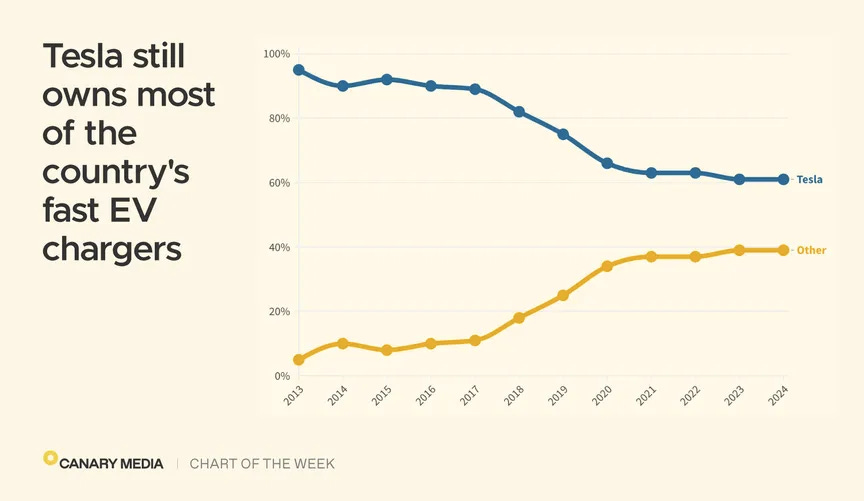
Compared to Tesla’s Supercharger experience, other charging networks feel like the dark ages. Over three years of fast charging our Leaf, we found that chargers often don’t work or that there are too few at a station, meaning we had to wait our turn. Sometimes we had to download an app to pay. And technical challenges are common. We could write a whole article about our negative and almost comical charging experiences, and we still hear horror stories from others. Just last week a friend reported that, enroute from Portland to Seattle, a fast charging cable got stuck to his charging port. After waiting on the phone for an hour, the charging provider told him they could have someone there to help remove the cable in five days! Desperate to continue his trip, and with two young kids in the back, our friend used a pocket knife to pry the malfunctioning latch free from the car.
Overnight Charging
Another important long distance driving strategy is overnight Level 2 charging. Multi-day EV road trips are much more manageable if you plug in at your nightly lodging, because you wake up with a full battery and save a daytime charging stop. We’ve shared some lessons learned from multiple cross-country EV trips.
The Future
A report by the National Renewable Energy Lab estimates there will be 33 million EVs on US roads by 2030 which means we’ll need 28 million charging ports. After trickle charging without a garage, and facing several comical road trip charging experiences, we’re highly encouraged by the increased convenience of both home and fast charging in the last seven years. We already laugh about the time we had to call the network provider to reboot a charger on the way to Astoria, Oregon. It’s likely that most remaining challenges will be solved in the next seven years and that fast charging will become as commonplace as gas stations and most homes will have chargers.
But even today, once you find the right home charging option for you and with the Tesla’s Superchargers for road trips, EVs are almost as convenient as gas guzzlers. Plus you save money and can stop feeling guilty about spewing fossil fuels in the air every time you pick up your groceries.
 This article is part of a series called Decarbonize Your Life. With modest steps and reasonable costs our family has dramatically reduced emissions and is sequestering what remains through a small reforestation project. Our life is better for it. If we can do it, you can too.
This article is part of a series called Decarbonize Your Life. With modest steps and reasonable costs our family has dramatically reduced emissions and is sequestering what remains through a small reforestation project. Our life is better for it. If we can do it, you can too.
Have a tip for CleanTechnica? Want to advertise? Want to suggest a guest for our CleanTech Talk podcast? Contact us here.
Latest CleanTechnica.TV Video

CleanTechnica uses affiliate links. See our policy here.

